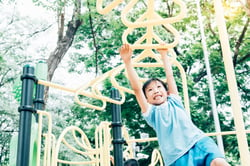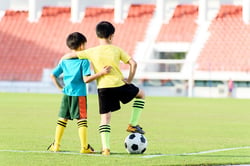Given the amount of time Singaporeans are homebound now, are parents feeling stretched keeping up with office work, while making sure your children are sufficiently occupied? (And no, it is not just leaving them to watch cartoons on an iPad or TV, which is at best passive screen time requiring little or no creativity.)
Fulfilling your parental duty aside, remember that you deserve time-out too, be it de-stressing over baking or watching the latest dramas, or simply spacing out while doing the dishes.
You would be relieved to know that your children stand to benefit from playing independently too. It helps them to:
- Develop focus, patience and confidence
- Learn how to be creative and independent
- Cultivate problem-solving skills
- Appreciate their toys and belongings more
- Understand that mom and dad need to be away at times
So how can we get our children started on playing independently (and grow to enjoy it)?
Set boundaries and expectations
Start with a fixed duration or timing, and explain to your child what you would like them to do within this timeframe. For example, to construct three Lego houses, for the next 30 minutes, while you get the laundry done. For younger kids, take note of creating a safe environment for their playing independently or alone - avoid activities requiring them to handle scissors or adhesives, or to be in the kitchen or outside.
Be part of their preparation to play alone
Talk to your kids first about this special play time. Brainstorm a list of activities together, and make it their mission, so they know they are accomplishing something created by both of you. If necessary, kickstart the first few minutes with them.
Refrain from interrupting them
Once they are focusing on the activity, leave them alone as much as possible, while keeping an eye from a distance. If it is your child who keeps turning to you, avoid giving in to every single request or answering every question. Remind them what is their �special mission� for these 30 minutes.
Wrap up with praise (and tidying up together)
When the time is up, check if your kids are still engrossed in the activity (and even enjoying it!). You may not need to stop them immediately, until it is time for a meal, snack or nap. Show interest in what they have completed, which could be Lego cars they constructed or drawings. Praise them, and thank them for accomplishing their �mission�. Just like you kickstarted the activity with them, wrap up by tidying up together.
Now that the foundation has been laid, what are the toys and kits that would be fun?
Art kits
Many kids love to draw and make crafts. If the latter may invite concern over unsupervised use of scissors and adhesives, you still have the drawing bit. Choose art kits that come with non-toxic crayons or colour pencils, or ready colouring sheets and books.
Building blocks
Most families probably have a Lego set (or more) � belonging to Dad if not the kids. The variety is so extensive, that it has even become a collectible. The best thing is, your kids can spend endless time constructing and de-constructing unlimited creations.
Puzzles and brain teasers
If your kid is older or prefers something more challenging, try piecing a puzzle, or solving (fun) problems in online apps or work books designed for different age groups.
Trains, dolls and figurines
Like building blocks, these encourage imagination and creativity. Children can make up and narrate stories when playing with these toys. If siblings are playing together unaccompanied by parents, they can learn to share and socialise.
The best part about all the above is that they are not only great distractions and time-killers for your children playing independently, but also for your family to enjoy together.





![ActiveSG Academies and Clubs Logo (Solid Colour)[8647]](https://www.activesgcircle.gov.sg/hs-fs/hubfs/ActiveSG%20Circle%202023Theme/images/ActiveSG%20Academies%20and%20Clubs%20Logo%20(Solid%20Colour)%5B8647%5D.png?width=150&height=65&name=ActiveSG%20Academies%20and%20Clubs%20Logo%20(Solid%20Colour)%5B8647%5D.png)



-01.png?width=200&height=141&name=Team%20Singapore%20Logo%20(Red)-01.png)












.jpg?width=250&height=250&name=CQ@Clarke%20Quay%20Poster.jpg%20(400x400px).jpg)
.png?width=250&height=250&name=CCE%2024%20April%20Coaching%20as%20a%20way%20of%20Life%20From%20(400%20x%20400%20px).png)

